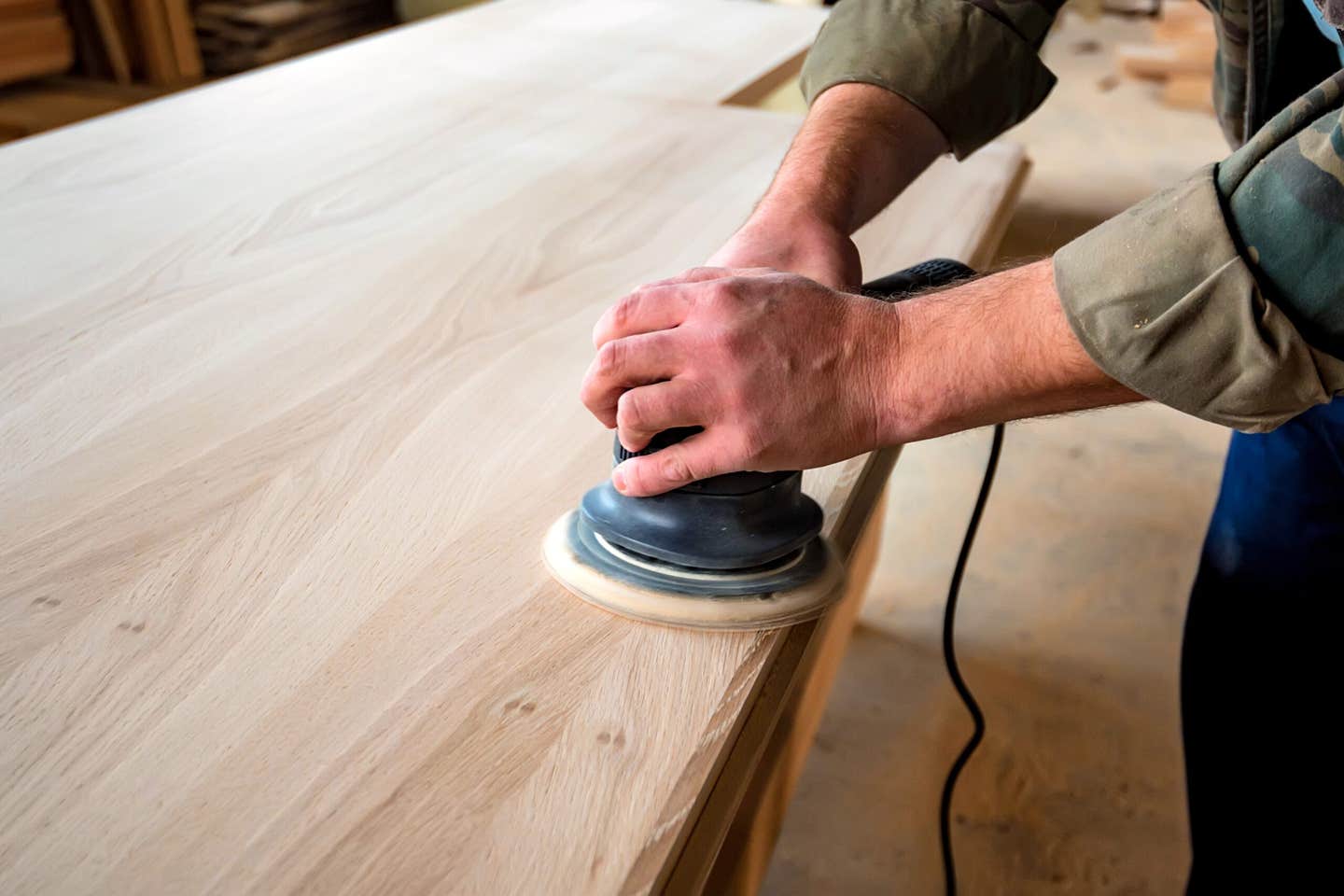Find the line and cross it
Scott Grove continues to push the boundaries as a maker, educator, inventor, writer and entrepreneur
Woodworking and veneer artisan Scott Grove of Green Grove Design in Canandaigua, N.Y. has always enjoyed a lifelong passion creating a vast array of furniture and sculptured pieces using wood and other mediums. His skills and dedication have earned him an extensive reputation and led him to teach nationally, overseas, and more recently, online courses.
A motivating instructor and entertaining video content personality, he’s enthusiastic about sharing woodworking knowledge and tips with anyone eager to learn. He says in this field, it’s best to invest all of one’s talents and skills into a diversified business model, as the consumer market is unpredictable.
“Some people would argue that going in many directions is not a good way to run a business because you’re always reinventing the wheel, but as a custom shop, you’ve got to be flexible and go with the flow. If all you want to do are kitchens and the kitchens dry up, you’re out of work. So, you need to stay flexible,” says Grove.
Grove has many different income streams under the Green Grove entity. They include his own work designing and fabricating custom furniture, doing architectural millwork and more. In partnership with his wife and son, he runs an exotic inlay supply company, Easy Inlay, and a content production business, ImagineGrove,com, that includes online teaching, a monthly Creative Corner newsletter, and book and tool sales. He also invented and sells a router base product, the Ultimate Router Base System.
Exploring talents, trades, materials
Raised in Croton-on-Hudson, N.Y., Grove is a third-generation designer from a family of engineers and artists who made a lasting impression on him. He became a professional artist at the age of 16 when he sold his first piece, a sculpture, at a gallery and was hooked.
He attended the Rochester Institute of Technology in the 80’s where he received a degree in environmental design with a minor in sculpture. The college also houses the School for American Crafts in its College of Art and Design where Grove took woodworking courses. He explored many vocational options throughout his 20’s, even a brief stint as a professional clown in which he turned down a job for Ringling Bros. He started Effective Design, a home renovation company with a business partner, and began seeking any training he could on construction aspects.
“I apprenticed as an electrician, a plumber, a mason under a master carpenter, under a woodworker. Each summer I would hook up with someone and learn as much as I could in the early days.”
The company grew to a 20,000-sq.-ft. facility with its own cabinet shop and at one point had 20 employees doing large commercial and residential jobs. All the while Grove was making small sculptures on the side using wood, steel and stone. He incorporated glass into one of his pieces and knew he found a niche making sculptural art furniture.
“I thought I just invented sliced bread,” he says.
Around that time, Grove worked on an exterior renovation on an element to a historic building that required fiberglass and added a fiberglass component to his shop. This led him to connect with Wendell Castle, the late studio furniture maker, who was known for art furniture and was a pioneer in fiberglass furniture. Castle was selling a chopper gun, a tool that sprays polyester and fiberglass, that Grove needed. Meeting Castle in his studio was a life-changing moment.
“Two things happened that day. One, I saw his art furniture and it validated what I was doing because someone else was doing it. I also saw a piece of curly redwood veneer that absolutely blew me away. I knew that veneer was something I wanted to work with for the rest of my life.”
By the late 80s, Grove took over the business from his partner and scaled it down to six to 10 employees.
“At this point I was fully committed to the art furniture movement and it was probably 50 percent of my business. I was doing all the major museum and furniture shows, basically up and down the East Coast, but I also did SOFA (Sculpture Objects Functional Art and Design Fair) in Chicago, New York City and San Francisco. So, I was doing that in addition to custom furniture.”
Most work was his own design, although he did connect with interior designers.
“One tip for anybody doing custom work is to connect with an interior designer because it’s the best of both worlds: you get repeat business and still get your full price.”
Grove dove heavily into his beloved veneer, learning everything he could by trial and error, and making his own techniques. Admitting to having a defiant nature, he sought an alternative to the common book-matching method and created what is now called the spiral match or asymmetrical matching technique, in addition to compound veneering.
He entered and won his first of four Craftsmen’s Challenge awards, a veneer contest in which he eventually became a judge. He was approached by Schiffer Publications to publish books on veneering, Advanced Veneering and Alternative Techniques and Hardwood Edging and Inlay for Curved Tables. He has self-published other woodworking and inlay books, too. He was invited to teach at the Marc Adams School of Woodworking in Franklin, Ind., and then to head the veneering program at the Chippendale International School of Furniture in Scotland.
In 2007, Castle, who’d supported Grove’s work all along, asked him to run his studio. It was a big honor and he accepted, and got his employees work at other shops before closing his. But with the Great Recession to soon follow, Castle had to downsize.
“After Wendell’s, I was the creative director for a local architectural firm for a few years and learned a lot. But then, I went back to working for myself for the first time in my life which was nice. I had enough of a reputation and momentum where I didn’t have to hustle as much.”
He officially formed Green Grove Design in 2009 and now works out of a 1,500-sq.-ft. shop with a separate 2,000 sq. ft. of storage. Working solo, he was finally able to focus on one-of-a-kind pieces he’d yearned to do. He expanded on his teaching doing select weekend gigs for woodworking clubs around the country, and on his writing for which he’s contributed to many industry publications, including Woodshop News.
Mixed bag of offerings
Figuratively speaking, perhaps his training as a clown helps him juggle all his endeavors, but Grove is grateful to have his wife, Nancy Napurski, and son, Zachary Grove, as his right-hand helpers. Both have extensive experience in marketing and public relations which help especially with his video content development and business success.
“When Covid hit we got thrown into remote teaching, so I jumped into that whole side of things right away. It’s worked out well because I’m teaching all over the world remotely. We’ve got a whole five-camera studio and green screen,” he says.
Several years ago, Grove designed his patent-pending Ultimate Router Base System, a solution for handling curved joinery.
“I wrote a book about curved joinery and through that process of writing the book and teaching the technique, I realized I wanted a tool that didn’t exist. I couldn’t find it, so I designed it myself,” he says.
He had prototypes manufactured and started selling them online. Around that time, he bought out a company’s inventory of inlay material and started Easy Inlay.
“The woodturners picked up on our beautiful inlay supplies, and then Covid hit and everyone is at home crafting. It really took off. It’s now a full-time business and Nancy runs the whole thing. Woodcraft picked us up, then Rockler, Timbecon, an Australian wood product supplier, and two other companies in the U.K. We’re now selling globally.”
A more relaxed schedule
While he’s busier than ever with back orders in his woodshop, Grove is letting things wind down just a little. He’s reducing his in-person teaching schedule because travel became excessive.
“I don’t think I’m ever going to retire. I’ll just keep making stuff. But I’m 62 now so I don’t feel a need to grow the company or the shop. I’m getting tired of lugging big furniture around so I’m making smaller pieces too.”
But Grove intends to keep sharing advice and helping others, circling back to recommending a varied business approach.
“There’s nothing wrong with doing something a little different that may support you following your passion. Making a living as a woodworker is not an easy thing because you’ve got to be good at it and it’s a competitive marketplace. But you might find a niche that takes you where you want to go.”
He encourages emerging talent through one of his favorite sayings that helped him be successful.
“One of my mottos is: Find the line and cross it. I tell students to push the boundaries all the time. Another is nothing is ever learned by doing it right. Making mistakes is very educational. We can take those mistakes and make them into something more creative.”
As a side note, Grove has an unusual hobby he shares with Nancy. The two were on the gymnastics team in high school and now do handstands at various landmarks around the world, even getting kicked out of museums at times in pursuit of the perfect photo. He follows his heart and has fun, in work and home life, and wants others to as well.
“Follow your passion. Life’s too short. You’ve got to enjoy what you do. If you enjoy what you do, it’s not work.”
For more visit: www.imaginegrove.com.
This article was originally published in the October 2021 issue.







